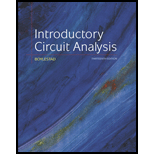
Introductory Circuit Analysis (13th Edition)
13th Edition
ISBN: 9780133923605
Author: Robert L. Boylestad
Publisher: PEARSON
expand_more
expand_more
format_list_bulleted
Concept explainers
Question
Chapter 16, Problem 3P
To determine
(a)
Admittance of the given networks in rectangular and polar form.
To determine
(b)
To draw:
Admittance diagram for each circuit.
Expert Solution & Answer
Want to see the full answer?
Check out a sample textbook solution
Students have asked these similar questions
Don't use ai to answer I will report you answer
Choose the correct answer for from the following sentences:
1. The purpose of the microprocessor is to control
b. memory
c. processing
d. tasks
a. switches
2. Which of the following instructions represents base-plus-index addressing mode?
a. MOV AL,[BX] b. MOV AL,[SI] c. MOV AL,BX d. MOV AL,[BX+SI]
3. The BIU pre-fetches the instruction from memory and store them in
b. memory
c. stack
d. queue
a. register
4. Which function is used to control the PWM (Pulse Width Modulation) on the Arduino
output pin?
a. digitalRead() b. analogRead() c. digitalWrite()
5. Which port in the PIC16F877A has an 8 external interrupt inputs?
a. Port-A
b. Port-C
c. Port-B
d. analogWrite()
d. Port-D
d. 4KByte
6. How much Flash EEPROM memory program found in the PIC16F877A microcontroller?
a. 32KByte
b. 16KByte
c. 8KByte
Solve and select the correct answer:
2. For a random variable X with pdf: p(x)
value of x is
=
119
10
for -5≤x≤5. The mean
(a) -75
(b) 10
(c) 0
(d) 75
3. Is the matrix A = = [1] orthogonal? Find the rank of A?
0
(a) YES, -1
(b) NO, 2
(c) YES, 2
(d) NO, -1
4. L{et sin(3t)u(t)) = (a)
s-3
(s-2)²+9
2
(b)
(5-3)² (c)
(s-3)²+4
S-2
3
(s-2)²+9
(d) (5-2)²+9
=
5. Given that x is a constant. Choose all the correct solutions for [∞ (AB)] =
(a) (AB)T (b) x ATBT
(c) α BTAT
(d) x (AB)T
Chapter 16 Solutions
Introductory Circuit Analysis (13th Edition)
Ch. 16 - Find the total impedance of the parallel networks...Ch. 16 - Find the total impedance of the parallel...Ch. 16 - Prob. 3PCh. 16 - For each configuration of Fig. 16.66: a. Find the...Ch. 16 - For each configuration of Fig. 16.67 a. Find the...Ch. 16 - For each network of Fig. 16.68: a. find the total...Ch. 16 - For the circuit of Fig. 16.69: a. Find the total...Ch. 16 - Given the voltage and current shown in Fig. 16.70,...Ch. 16 - For the network in Fig. 16.71: a. Find the total...Ch. 16 - Repeat Problem 9 for the network in Fig. 16.72,...
Ch. 16 - For the network of Fig. 16.73: a. Find the total...Ch. 16 - For the network in Fig. 16.74: a. Find the total...Ch. 16 - Repeat Problem 12 for the circuit in Fig. 16.75...Ch. 16 - Calculate the currents I1 and I2 in Fig. 16.76 in...Ch. 16 - For the parallel R-C network in Fig. 16.77: a....Ch. 16 - For the parallel R-L network in Fig. 16.78: a....Ch. 16 - Plot YTandT(ofYT=YTT) for a frequency range of...Ch. 16 - Plot YTandT(ofYT=YTT) for a frequency range of...Ch. 16 - For the parallel R-L-C network in Fig. 16.79. a....Ch. 16 - For the series circuits in Fig. 16.80, find a...Ch. 16 - For the parallel circuits in Fig. 16.81, find a...Ch. 16 - For the network in Fig. 16.82: a. Calculate E, IR,...Ch. 16 - Find the element or elements that must be in the...Ch. 16 - For the network in Fig. 16.13 (usef=1kHz): a....Ch. 16 - For the network in Fig. 16.32: a. Plot the...
Knowledge Booster
Learn more about
Need a deep-dive on the concept behind this application? Look no further. Learn more about this topic, electrical-engineering and related others by exploring similar questions and additional content below.Similar questions
- DO NOT WANT AI WILL REJECTarrow_forward3. Roughly sketch the root locus for the following locations of open-loop poles and zeros. You just need to show the shape of the root locus; you do not calculate the asymptote, break-in, and break-away points. ☑ (a) (b) ☑ Φ ① $3 (c)arrow_forwardDO NOT WANT AI WILL REJECTarrow_forward
- 5. Sketch the root locus for L(s) = s+10 using rules 1, 2, and 4. For rule 4, you need to s(s+6) find the break-in and break-away points.arrow_forwardS+4 4. Sketch the root locus for L(s) = (s+6) (s+1)2 using rules 1, 2, and 3. For rule 3, you need to find the value of σ and a for the asymptotes. From the root-locus, explain why the closed-loop system is always stable for any choice of the design parameter K in the range 0 < K < ∞o.arrow_forward2. Consider the following system. K(s+3) (s+4) (s+1)(s+2) Check whether the points below are in the root locus. If the point is in the root locus, then also find what the corresponding gain K. i) ii) -2+j3 -2+1√ √ Hint: First find L(s). Next, in L(s) replace s with the value of the point and then express it in polar format r20 using calculator. The point will be in the root locus if and only if = 180° or odd multiple of 180°. When the point is in the root locus, the corresponding gain K is obtained as K ==arrow_forward
arrow_back_ios
SEE MORE QUESTIONS
arrow_forward_ios
Recommended textbooks for you
 Power System Analysis and Design (MindTap Course ...Electrical EngineeringISBN:9781305632134Author:J. Duncan Glover, Thomas Overbye, Mulukutla S. SarmaPublisher:Cengage Learning
Power System Analysis and Design (MindTap Course ...Electrical EngineeringISBN:9781305632134Author:J. Duncan Glover, Thomas Overbye, Mulukutla S. SarmaPublisher:Cengage Learning

Power System Analysis and Design (MindTap Course ...
Electrical Engineering
ISBN:9781305632134
Author:J. Duncan Glover, Thomas Overbye, Mulukutla S. Sarma
Publisher:Cengage Learning
